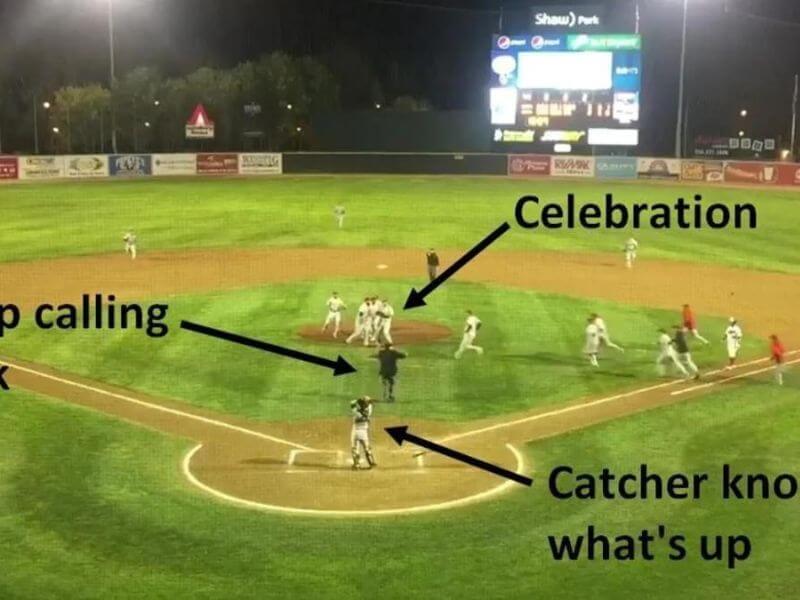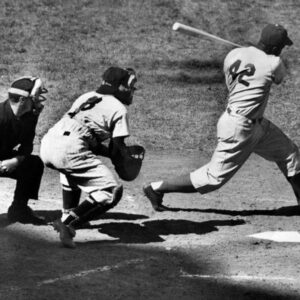What is a balk in baseball ? You may have seen it, even if you were casually watching a baseball game: A pitcher makes a small move on the mound, and then the umpire stops play and signals for the runners to move forward one base — all with seemingly no action taking place. The television broadcasters spend a few seconds discussing a funky word called a “balk,” and then play resumes.
But what exactly is a balk? It’s one of baseball’s more intricate rules, with a long list of permutations, sometimes even leading to confusion between those on the field. But the balk essentially keeps the pitcher in check by limiting his ability to fake a pitch or a pick-off throw to one of the bases. If an umpire deems the pitcher pretended to do either, without clear intention of following through, the balk is called and each of the runners move up one base.
As complex as the balk appears, its rules come down to a list of dos and don’ts for pitchers. First and foremost for all pitchers is this rule: After they agree on a pitch with their catcher, pitchers must get to the set position — or a complete stop with the body still and the hands together — before starting their motion toward home plate. If there’s any fluidity between receiving the sign and throwing home that skips the set — or if a pitcher flinches during the set — the umpire can call a balk. A pitcher also cannot switch from the windup back to the set without fully stepping off the pitching rubber. And if their hands come apart from the set without either immediately delivering a pitch or a pickoff throw, that’s a balk too.
Now, let’s move to left-handed pitchers, those crafty southpaws who have a straight-on view of the runner at first base. Once a lefty raises the right foot, he or she must land it toward the direction in which they plan to throw. Picture a line on a 45-degree angle shooting out from the pitcher’s grounded left foot; if he or she is throwing to first, their right foot must land on the left side of that line. If they’re throwing home, that foot must land on the right side of the line.
Righties, who face the third-base side, must complete their motion once it begins — and it must be in a clear direction toward either a) home plate or b) the base to which they are throwing. When turning to make a pickoff throw to first, righties can’t stop mid-motion unless they step off the pitching rubber. If they do, a balk will almost always follow.

Balk (BK) & Disengagement Violation (2023 rule change)
A balk occurs when a pitcher makes an illegal motion on the mound that the umpire deems to be deceitful to the runner(s). As a result, any men on base are awarded the next base, and the pitch (if it was thrown in the first place) is waved off for a dead ball.
In September 2022, Major League Baseball announced three rule changes that were approved by the league’s Competition Committee.
The Pitch Time rule change stipulates the following around disengagement violations:
Pitchers are limited to two disengagements (pickoff attempts or step-offs) per plate appearance. However, this limit is reset if a runner or runners advance during the plate appearance.
A third disengagement, or a disengagement violation, would result in a balk.
For example, if a third pickoff attempt is made, the runner automatically advances one base if the pickoff attempt is not successful.
Mound visits, injury timeouts and offensive team timeouts do not count as a disengagement.
If a team has used up all five of its allotted mound visits prior to the ninth inning, that team will receive an additional mound visit in the ninth inning. This effectively serves as an additional disengagement.
Exactly what constitutes a balk is summed up in section 8 of the MLB rules, which describes a legal pitching delivery.
Pitchers with high balk totals are also generally adept at picking runners off, this being because their moves to first base are typically so deceptive that they border on being illegal. Any umpire, if he notices an illegal movement by the pitcher, can call a balk.
What Is A Balk?
A balk is an illegal pitch in baseball, and can be called by any umpire at any level of the game. It is most commonly called when a pitcher makes a motion to deliver a pitch while either one or more runners are on base, or when the pitcher attempts an illegal quick pitch.
The origin of the term “balk” can be traced back to old English games like rounders and cricket. These games featured rules about where players could move their feet during certain parts of play (similar to modern day baseball). A “balk” was used to indicate when someone broke those rules. Today, balking still plays an important role in keeping players honest and preventing them from illegally manipulating play to their advantage.
Common Causes Of Balks
Looking at different teams’ balk totals can help us understand trends in how these calls are made. Generally speaking, balks with runners on base occur more frequently than those without runners on base. This discrepancy is likely due to pitchers attempting to intentionally deceive their opponents by quickly delivering the ball while they still have a chance of being caught off guard.
An understanding of why balks are called can be beneficial for both players and coaches alike. By knowing what constitutes a balk and what kind of behavior may lead to one, players and coaches can work together to prevent them from happening as much as possible. This will help teams avoid costly penalties and keep their games running smoothly.
The Set Position
Almost all situations in which left-handed or right-handed pitchers balk in Major League Baseball take place in the set position. There are three deliveries that pitchers can use: stretch position, windup position, or set. Pitchers frequently throw from the set position if there is an unoccupied base. They step back with the rear foot, rock, and throw while keeping their body towards the batter at this point.
The pitcher is in the set position when his or her body forms a T with the pitching rubber and is turned perpendicular to it. Before kicking or sliding and throwing the ball to the home plate while in the set position, pitchers must bring their hands together and halt completely. A balk is recorded when the pitcher draws their hands together, does not stop, and just throws the ball to the home plate.
The crucial point to remember about the set position is that pitchers cannot shrug their shoulders or flinch while they are in it (this is an illegal motion). They can gaze at the base runner by turning their heads, but they are unable to shrug or pretend to recoil. This qualifies as a balk.
Fake Throw
The only base to which you cannot fake throw without first stepping off the rubber is first base. You must throw to first if you go towards first. A pitcher has the option to throw or fake a throw to any base whenever they leave the rubber. The pitcher, though, is unable to simulate a pickoff motion to first.
Pitchers are also prohibited from making a deceptive move to any base other than first base. For instance, the pitcher cannot pretend to throw to third and then attempt to pick out the runner at first if there is a runner on first. This would qualify as a balk.
Prior to 2013, baseball rules stated that the pitcher might attempt to pick off the runner on first by pretending to throw to third with a runner on first and third. Major League Baseball changed the rules in 2013 to make it a “fake to third, throw to first” pickoff motion an illegal throw.
Penalties For Balks
When a balk is called, it is the plate and field umpire’s responsibility to note an illegal action and correctly enforce the rule. Every movement made by a pitcher must be part of a continual motion towards home plate, and if his foot moves from its legal position in any way, an alert umpire can call a balk. The enforcement of balks varies depending on the situation and what league you’re playing in.
In Major League Baseball, when a pitcher commits a balk, they make an improper action on the mound that the plate umpire determines to be misleading to the base runner or runners. As a result, any runners already in scoring position are advanced to the following base, and the pitch (if it was ever thrown in the first place) is ruled a dead ball.
Even with strict enforcement of rules, actual records of balks may not reflect the true number that occur during games. Since there is no official statistic for balks, much like errors for fielders, it is difficult to determine how many are actually happening each game. Therefore, some teams have started tracking them themselves to better understand their players’ performances.
Strategies To Avoid Balks
Base coaches should be aware of the current base trends, and advise runners to either advance without hesitation or stay put without liability. This allows them to decide whether or not they should attempt to steal a base without possession. Additionally, pitchers must remember to keep their pivot foot in place until they have completed their pitching motion. Doing so will help them avoid making sudden movements that could result in a balk call.
Finally, it is important for teams to understand and practice strategies for avoiding balks during tie game situations. This is especially true when there are runners in scoring position and the team needs to maximize their chances of scoring. By being aware of these strategies, coaches can ensure that their players understand how to move safely around the bases while minimizing risk of a balk call against them.
How Balks Affect A Game
At the end of the day, a balk disrupts the rhythm of the game. It can also be seen as a form of cheating, as it often gives the pitcher an advantage over their opponent. Balks are not counted against a pitcher’s earned run average (ERA) but they do count towards their base totals.
The most common type of balk is when a pitcher moves off the pitching plate in any direction prior to delivering the ball to home plate. In this case, the pitch is called no pitch, and all runners advance one base from their previous count. If there are runners on bases, this can result in an extra base or even a base hit for the opposing team.
In some cases, balks may also occur during pick-off attempts or if a pitcher does an additional action after coming to set on the mound without delivering a pitch. By definition, all runners advance one base in either direction from their previous count and depending on how far they already were around bases, this could result in them scoring additional points and affecting the outcome of the game. As such, balks can have serious implications with regards to pitchers’ stats and should be avoided whenever possible in order to maximize success.

How to Throw a Fastball Better
John Tumpane is an example of a player who has been affected by balks in baseball. In 2014, he was playing 3rd base for the Pittsburgh Pirates when he committed a hidden ball trick against the offensive team the St. Louis Cardinals. That led to his team being penalized with two balks, which caused them to lose the game.
The rules of balking can have a significant effect on strategy and performance for baseball players and teams alike. Without having strategies in place to protect against these calls, teams could find themselves in trouble quickly as each penalty awards bases to the batting team. As such, it’s important that both players and coaches take steps to prevent and prepare for a call of this nature during games.
The Debate Over The Balk Rule
The debate over the balk rule in baseball has been a hot topic for many years. One of the main points of controversy is whether or not a pitcher can make any kind of motion while on the mound without it being counted as an actual balk.
For example, can a right handed pitcher step off the rubber with his right foot and pivot towards 1st base, even if his left hand does not come up at the same time? Or can a left handed pitcher turn his back slightly when starting his motion towards third base without it being classified as an illegal move?
In order to determine what is considered an illegal move, MLB states that any movement by the pitcher that is deemed “not part of continuous motion” will constitute as a balk. This means that if a pitcher starts his delivery and then stops or changes direction at any point after crossing the degree angle from home plate to either 1st base for righties or third base for lefties, this could be considered an illegal move and result in a ball slip. Thus, understanding what counts as balks on pitchers can provide clarity for teams looking to get an edge on offense.
Above is information what is a balk in baseball. Hopefully, through the above content, you have a more detailed understanding of what is a balk in baseball .Thank you for reading our post.









